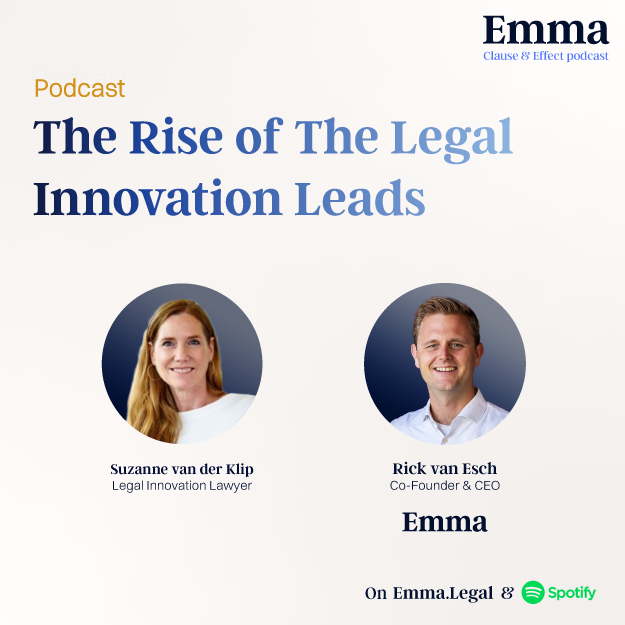Featuring insights from Connor O’Hearn, this article explores how AI is becoming the new currency of leverage in M&A. O’Hearn, founder of MAAI Services, outlines how lean deal teams are outpacing larger firms by using tools like Emma Legal to automate diligence, uncover insights, and compress timelines. He argues that AI isn't just about efficiency. It’s a career accelerant, a strategic edge, and a sign of maturity that LPs are starting to expect.
When Connor O’Hearn first started experimenting with GPT-3 in 2022, AI felt like a playground for software engineers and not something that belonged in an M&A process.
“Developers were the early adopters,” he recalls. “Meanwhile, lower-middle-market deal teams were just too busy to keep up.”
Fast forward to 2025, and O’Hearn’s firm, Maai Services, is now helping private equity funds, VCs, family offices and law firms to bring AI into every stage of the deal lifecycle.
We sat down with him on the Clause and Effect podcast to explore where AI really delivers value, why smaller firms are leading the way, and how today’s PE analysts can use AI to level up faster than ever before.
What AI actually unlocks in M&A workflows
At its core, AI isn’t magic. It’s leverage. O’Hearn breaks its value into three categories:
Three places to start with AI
These aren’t theoretical use cases; they’re the entry points Connor sees delivering real impact in firms today. Start here, build momentum, and let the results speak for themselves.
- Legal due diligence
Tools like Emma automatically label, sort, and summarize thousands of documents against your checklist. “It’s like starting the review at 20 miles per hour instead of zero,” says O’Hearn. - Sourcing intelligence
Imagine pulling fragmented deal notes from calendars, emails, and slide decks into one searchable AI assistant. Suddenly, that cold lead from last quarter might be worth a second look. - Portfolio insight
Use AI to scan board updates, dashboards, and customer notes to catch signals early before problems get buried or opportunities get missed.
So why hasn’t everyone adopted this?
O’Hearn sees three common blockers:
- Change aversion – “I’ve been doing deals this way for 20 years” still dominates many rooms.
- Wait-and-see mindset – Most firms would rather let someone else go first.
- Security concerns – Uploading sensitive docs into a chatbot is a non-starter unless the tools prove SOC 2 and GDPR compliance (as Emma does).
His take? Start small. Run a low-risk pilot. Once the time savings are visible, momentum builds on its own.
Why the smallest firms are moving fastest
It’s not the big firms leading the charge, it’s the lean ones.
“These three-to-five-person teams don’t have time to waste,” O’Hearn says. “AI gives them the leverage to move faster, make smarter decisions, and play on a much bigger field.”
And LPs are noticing. More and more fund managers are getting asked, “How are you implementing AI?”
AI is flattening the career ladder
Traditionally, climbing the ladder in private equity or law meant 20+ years of grunt work. But AI is changing that.
The new advantage? Being AI-bilingual.
“You still need to know how to build a model or write a memo,” O’Hearn says. “But if you can also prompt, build simple workflows, and identify automation opportunities, you can shortcut the grind.”
He encourages junior analysts to pilot tools internally and champion small wins. “Be the one who brings a solution. That’s how you stand out.”
More orchestration and agents
O’Hearn points to something bigger than just smarter chatbots, but orchestrated systems where AI tools connect with legacy software, passing information and decisions back and forth automatically.
Think:
- AI that updates valuation models with fresh data
- Board decks generated overnight from raw metrics and commentary
“That’s the vision,” he says. “Not just chatbots, but workflows that actually work together.”
Efficiency is just the beginning
Many teams think of AI as a time-saver. And it is. But O’Hearn says that’s only the first layer of value.
“Yes, you save time. But you also make better decisions because you’re working with cleaner data, clearer insights, and fewer blind spots, all on compressed timelines.”
That matters in M&A, where velocity is critical.
Final thoughts on how to bring AI into M&A
O’Hearn recommends a four-step approach:
- Start with curiosity: Play with it. Ask questions. Learn what’s possible.
- Find the low-hanging fruit: Target repetitive, high-effort workflows.
- Scale what works: Codify it, and roll it out across teams.
- Go beyond efficiency: Use the time you save to elevate quality, strategy, and creativity.
“Don’t just chase speed,” he says. “Chase insight. That’s where the future is.”
And in a world where the smallest funds are already thinking like giants, the real edge is no longer size, it’s leverage.
Other related podcasts

The Rise of The Legal Innovation Leads
Discover how law firms are embracing legal innovation beyond buzzwords. In this interview, Suzanne van der Klip, M&A lawyer-turned-innovation lead shares how to drive real AI adoption in legal workflows from due diligence to deal execution.
Read

Europe vs US deal habits that reshapes your M&A playbook
Europe vs US M&A deal habits: from locked box pricing to disclosure letters and W&I insurance that reshapes your playbook. Learn how to navigate key differences and turn them into deal-closing advantages.
Read

AI for lawyers is here. Now what?
AI for lawyers is here. Omar Puertas, partner at Cuatrecasas, explains where gen-AI adds value, where it fails, and why firms must start experimenting with Emma Legal.
Read
